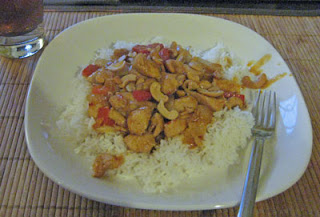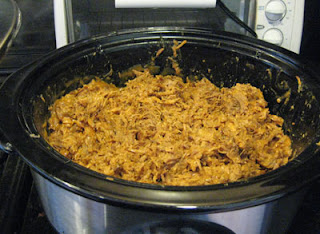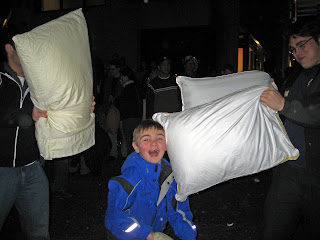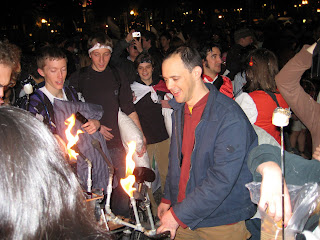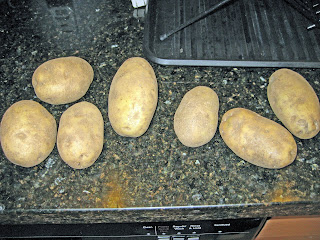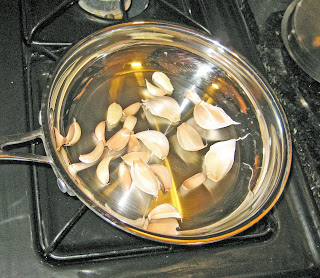My concentrated effort to become more asian has spilled over into the kitchen. Unfortunately, I was just as (un)successful in the kitchen as elsewhere.
Because of Inbae (my ex-roommate), Shen, Vicky, and many others in college, Korean has become one of my favorite types of food. I’m still a little picky about what I eat, but in general, I like a lot of their dishes.
When I was in Korea, Inbae’s mom made Dak Jorim, a Korean chicken dish. Ebay’s mom was happy to give me the recipe. Also, a typical Korean side-dish is Jap Chae, which is essentially stir fried vegetables with noodles. I don’t like most Jap Chae I get (Brother’s restaurant in SF is an exception), but I thought if I was making it, I could make it to my tastes.
Anyway, here’s the outcome:

First, I’ll show you how I made the jap chae, and then the dak jorim. Then, I’ll tell you how it turned out (if you can’t guess already). As a disclaimer, remember this is my first time cooking it, and I’m not exactly an expert cook, especially at asian cuisine.
So Jap Chae calls for some fancier mushrooms, so you usually just get them dehydrated and add some water. I got some shitake mushrooms.

I let them soak for a half hour (what the instructions said) in a bowl of room temperature water.

After a half hour, I took them out and put them on a paper towel. I don’t know if it’s shitakes in general or just dehydrated ones, but they really didn’t smell too hot. The texture, after rehydrated, was also a little funny, but the taste wasn’t too bad.

Here are the veggies I’m putting in the jap chae. I decided to put onions, spinach, carrots, mushrooms, green onions, and a bell pepper. I also added some diced garlic and egg as well.
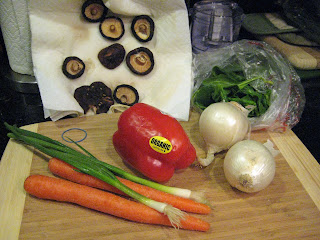
One thing I learned from my sweet cookbook, Best Recipes, which is to use scissors to cut green onions. Actually using scissors when cooking is a pretty Korean thing and can come in quite handy. Note that I didn’t use that cookbook for any of these recipes — I just happened to pick up some helpful hints from it which I’m applying here.

Now for the carrots.

I wanted to make everything look really good, so I decided to julienne cut most of the vegetables. If you don’t know what that is, it looks kinda like a shoestring. There are some great videos online on how to julienne a carrot, and I know I won’t be doing it justice with these photos, but here’s my attempt.
This is what the outcome will look like (it should be a little more uniform, but this was my first attempt):

First, I peeled the carrots. Since I am julienning it and squaring it off anyways, I don’t know if there was a point to this. Next time I probably won’t peel them, but I played it safe this time. I then cut them into a few smaller pieces.

I took each piece and tried to square off the edges. This makes it easier to cut because there’s a flat side, but it’s also part of the julienne process since we want rectangular cuts.

After squaring it off, I cut off some slices and stacked them up.

Then I cut them down again into little shoestrings. After it was all done, here’s what I was left with:

Now for the bell pepper. Since I was on my julienne frenzy, I cut off the top and the bottom.

I opened it up, removed all the stuff from the inside, and cut it into nicer, more uniform slices.

I then just cut it down into slices.

The onions are up next. They’re a little harder to julienne, so I just cut them up into some nice slices.

And here they are…

Mushrooms: into slices as well. They had a little weird texture when cutting, but it worked out fine.

Tada

Here are the majority of veggies for the jap chae.

We also need some diced garlic. Someone complained last time that I didn’t explain all the steps in dicing garlic. Since this isn’t a cooking show (b/c I’m no expert), I just arbitrarily decide what to show you guys. This time, I’ll go into some more detail (though my photos leave a lot to be desired).
I also didn’t know how to chop up garlic when I started and still find it a hassle. Anyways, here’s the garlic:

The key is to take your knife and smash it down against the garlic. This lets you peel the skin right off. Since we’re gonna dice it up anyway, don’t go easy on the garlic and take out some aggression (it makes the skin easier to get rid of).


I usually use two hands when smashing, but one-hand was taking the photo, so this was as good as I could do.

Once you smash it, peel the skin, and then just dice away.

I decided to also add some egg to the jap chae. Since we want to slice it, we want it to be pretty. When I normally make scrambled eggs I shake and stir it around a lot. For this, though, I let them sit for a while to make sure it was flat.
Start with our eggs.

Crack them open.

Then oil the pan a little. I put some vegetable oil in and then used a paper towel to wipe up a lot of the excess. I’m not sure if this is necessary, but I saw someone do it when making tamago (egg used in sushi).

Pour the egg in.

Let it sit until some edges develop.

Once it looks like it’s hardening up a bit, I cut it into smaller slices and moved them away from the center to pour any remaining goop into the center to cook with the rest of the egg.

Then I flipped it all over.

And there we are. Perfect for slicing.

Tada…

Now, for the noodles, I put up some water to boil.

These are my special Korean vermicelli noodles (thanks Joann). They’re made of different stuff then the white people’s vermicelli noodles.

After the water boils, I threw them in.

After about 7 minutes or so, they were ready. I took them out and drained them. However, unlike normal pasta, the directions also say to run cold water on top of them a few times and keep draining them after that (not sure why). At any rate, I put some cold water back in and drained it two times.

The jap chae recipe called for some toasted sesame seeds. I only had sesame seeds. I took about 2 teaspoons of those.

Too lazy to see if this was correct or not, I put them in a pan over low heat and kept shuffling them around. Perhaps you’re supposed to toast them in an oven, but this is what I decided to do. In the end, I wasn’t really sure if it was actually toasted, but it seemed about right 

A particularly asian cooking oil is sesame oil, and that’s what this recipe called for.

I put about 2 tablespoons in the pan, heated it up a bit, and then put in the veggies. I left out the spinach and the egg because those can cook a little less.

Let it heat up for a while (about 5 minutes or so)

Add some salt.

And some pepper.

After it’s done, I put some more sesame oil in (another 2 tablespoons).

Then I put in the noodles and the vegetables. I tried stirring it all around, but it didn’t really work.
One step I added that was definitely necessary (and I didn’t take a picture of), is I grabbed some scissors and cut the noddles up a bit. This made it a lot easier to stir and mix the veggies in with.

I also added the egg and some salt and pepper.

After a few minutes I put the veggies back in and then added some soy sauce. Since I like soy sauce (and usually not jap chae), I added a bit extra then the called for 1.5 tablespoons.
 Now for our “toasted” sesame seeds.
Now for our “toasted” sesame seeds.

And voila we are done. Personally i think it looks damned good.

Now for the chicken. I always use costco chicken because it’s the easiest thing. I just go buy some packs from them. Then I just put the individual packs (which still have quite a lot in each one) and freeze them. Each of these packs contains 5 drumsticks that I had taken out a day or two before to let thaw in the refrigerator.

Here they are. I decided I would try taking the skin off some and leaving it on others to see if it made a difference. In the end I actually forgot about this so didn’t run a taste test.

It seems weird to boil chicken, but that’s what the recipe calls for, so I took out a pot and filled it with water.

Let it boil…

Now, in this step, I was supposed to start sticking the chicken in there, but it was at this point I realized my pot was too small. So I had to get a bigger one out and start the process over.
Pot #2:

Here we are…

Chicken goes in.

Let it boil. I’m told the point of this is to let it cook a bit and to remove some of the fat and gunk the chicken has.

As you can see, there’s some nasty stuff on top. This was after about 10 minutes.

I took the chicken out and drained the water.

The sauce is made of garlic and soy sauce. You can also add some red pepper powder (which is what I did). First dice up the garlic — same way as for the jap chae.

Here’s our soy sauce (same as used in jap chae)

The recipe called for 8 tablespoons. Since I had a big pot, I decided to use about 12. Then I put the garlic in as well

Then some red pepper paste (as much as I feel like). Perhaps I’ll try more next time.

And here we are.

Chicken goes in.

Then we fill it with water until the chicken is covered.

We also add 2 tablespoons of sugar.

Since we’re trying to boil this water out, I think next time using less water (much less) is advised. I ended up spooning some of this delicious (or what should be delicious) sauce out of there so the chicken wouldn’t end up overcooked.
Here it is boiling some.

I checked the chicken with my oh-so-handy thermometer to make sure it’s cooked, and at 182, it definitely is.

Now that we’re done, to thicken the sauce, we’ll add some corn starch.

I took the corn starch and added it into the pot. I wasn’t sure of the best way to add it in, so I just threw it on top and tried to stir/slosh it around to mix it in.

Here’s what we end up with. It’s a little clumpy (some of it’s chicken pieces and some of it’s clumps of corn starch).

After some more mixing and some more red pepper powder, we get this, which doesn’t look half bad.

And here’s the final plating:

So cooking Korean food was definitely an adventure. Personally, I didn’t really like either of the dishes. The chicken was a little bland, and the jap chae just didn’t taste good to me. But I normally don’t like jap chae, so go figure. Other people who ate the food didn’t seem as picky as me, though. Regardless, I still think the jap chae *looks* amazing, and that’s gotta count for something…
Hopefully my next korean attempt will go better. If you’ve got suggestions/ways I can improve, lemme know.

So this place has definitely moved up to the tops in my list. Pani puri also has risen as a favorite food of mine.





























